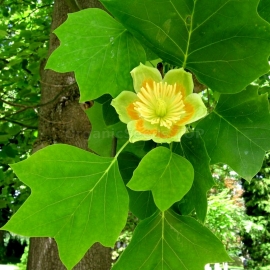










Organic Tulip Tree Seeds (Liriodendron Tulipifera)
1.39 €
The Tulip Tree (Liriodendron tulipifera) is definitely a tree to plant for the long term. The allure of a tree with tulip-like flowers is strong; even though it can take 20 years before the large green and orange tulip-shaped flowers.
-
Organic Tulip Tree (Liriodendron Tulipifera)
The Tulip Tree (Liriodendron tulipifera) is definitely a tree to plant for the long term. The allure of a tree with tulip-like flowers is strong; even though it can take 20 years before the large green and orange tulip-shaped flowers appear they are worth the wait! But there are plenty of other reasons to grow this ornamental tree.
When the tree is young, the distinctively shaped, glossy leaves are the tulip tree’s main attraction; they open bright green before turning brilliant yellow in autumn.
Liriodendron tulipifera is an ancient species of tree that belongs to the same plant family as magnolias. This tree grows fast, and eventually becomes very large, so site it with care.
If it is not possible to plant because soil is waterlogged or frozen keep the trees somewhere frost free and airy. Keep the roots just moist by storing them in damp compost or if outside conditions allow, heel the trees in to a patch of bare ground until you’re ready to plant them into their permanent positions.
How to Grow
Tulip Tree seeds have a deep dormancy within them, this requires a degree of patience to overcome. In addition the seeds almost always have a low viability typically around only 10%.
To begin the pretreatment process first soak the seeds in water for 24 hours.
Next prepare a free draining substrate into which the seeds are to be mixed, moist sand is thought to give the best results for this although you could use a 50/50 mixture of compost and sharp sand, The chosen substrate needs to be moist (but not wet), if you can squeeze water out of it with your hand it is too wet and your seeds may drown and die.
Mix the seeds into the substrate, making sure that their is enough volume of material to keep the seeds separated. Place the seed mixture into a clear plastic bag (freezer bags, especially zip-lock bags are very useful for this -provided a little gap is left in the seal for air exchange) If it is not a zip-lock type bag it needs to be loosely tied. Then write the date on the bag so that you know when the pretreatment was started.
The seeds require a cold period to break the dormancy that is naturally found within them, this is easily achieved by placing the prepared bag of seeds and compost mix in the fridge (4 Celsius or 39F) for between 12-16 weeks. It is quite possible for the seeds to germinate in the bag at these temperatures when they are ready to do so, if they do, just remove them from the bag and carefully plant them up.
For larger quantities it is easiest to sow the seeds in a well prepared seedbed once the cold pretreatment has finished and wait for the seeds to germinate.
Do not expose newly sown seeds to high temperatures (above 25 Celsius) otherwise a secondary dormancy may be induced and the seeds will not germinate until they have been pretreated again. Germinated seeds can be planted in deep pots or plug trays in a good quality compost. Keep the seedlings well watered and weed free.
Growth in the first year is usually between 15 and 40 cm and usually trouble free. Growth accelerates rapidly in the second year. Allow them to grow for 2 or 3 years before planting them in a permanent position.
